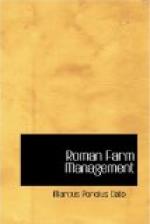XXXV. These are the things to do during the seventh season between the setting of the Pleiades and the winter solstice. Plant lilies and crocuses and propagate roses, which may be done by making cuttings about three inches in length from a stem already rooted, set these out and later, after they have formed their own roots, transplant them. The cultivation of violets has no place on a farm because they require elevated beds for which the soil is scraped up and these are damaged or even washed away by heavy rains, thus wasting the fertility of the land. At any time of the year between the rising of the west wind and the rising of Arcturus (February-September) it is proper to transplant from the seed beds thyme, an herb, which owes its name, serpyllum, to its creeping habit (quod serpit). This is the season also to dig new ditches, clean the old ones, and to prune the trees in the arbustum and the vines which are married to them, but be careful that you suspend most of your work during the fifteen days before and after the winter solstice: it is fitting, however, to set out some trees during this period, as, for example, elms.
8 deg. December 24-February 7
XXXVI. These are the things to do during the eighth season between the winter solstice and the rising of the west wind. Drain the fields, if any water is standing on them, but if they are dry and the land is friable, harrow them. Prune the vines and the orchard. When it is not fitting to work in the fields then those things should be done which can be done under cover during the winter twilight.
All these rules should be written out and posted in the farmstead and the overseer especially should have them at the tip of his tongue.
Of the influence of the moon on agriculture
XXXVII. The lunar seasons also must be considered. They are divided into two terms, that from the new moon to the full, and that from the full moon to the next moon, or until that day which we call intermenstruus, or the last and the first of a moon, whence at Athens this day is called [Greek: henae kai nea] (the old and the new), though the other Greeks call it [Greek: triakas] the thirtieth day. Some agricultural operations may be undertaken with more advantage during the increase of the moon, others during the decrease,[88] as, for example, the harvest or cutting of wood.”
“I observe a practice which I learned from my father,” said Agrasius, “not only never to shear my sheep, but not even to have my own hair cut on the decrease of the moon, for fear that I might become bald.”
“What are the quarters of the moon,” said Agrius, “and what bearing have they on agriculture?”
“Have you never heard in the country,” said Tremelius, “the lore about the influence of Jana (Diana) on the eighth day before her waxing, and again on the eighth day before her waning; how certain things which ought to be done during the increase can be done to better advantage in the second quarter than the first, and that what ever is fitting to do on the wane of the moon can be better done when her light is less? This is all I know about the effect of the four quarters of the moon upon agriculture.”




